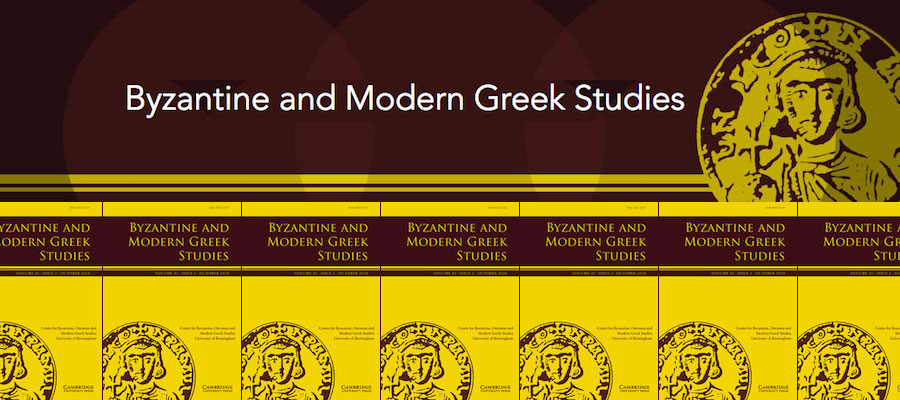Byzantine and Modern Greek Studies, volume 44, issue 1 (April 2020).
CONTENTS INCLUDE
Trapped in the imperial narrative? Some reflections on warfare and the provincial masses in Byzantium (600-1204)
Yannis Stouraitis
The experience of war of the common people in the medieval East Roman Empire is a topic related to hotly debated issues such as collective identification and attachments, or imperialism and ecumenical ideology. This paper attempts a bottom-up approach to the way warfare was perceived and experienced by provincial populations based on the analysis of selected evidence from the period between the seventh and the twelfth centuries. It goes without saying that the treatment of the topic here could not be exhaustive. My main goal was to problematize the relationship between the objectives of imperial military policies and the pragmatic needs of common provincials for protection of their well-being.
Seven Byzantine lead seals from the museum of Ödemiş in western Anatolia
Ergün Laflı and Werner Seibt
This short essay presents seven Byzantine lead seals, all of which originate from the local museum in Ödemiş in the province of Izmir in western Turkey. Almost all of them came as acquisition to Ödemiş by local antique dealers. All the pieces have been treated and interpreted here sigillographically for the first time. This small collection of seals is important regarding the administration of the theme of Thrakesion, especially about the offices of the seal owners, and the society of Cayster valley during the Byzantine period.
Agricultural production and installations in Byzantine Cappadocia: a case study focusing on Mavrucandere
Nilüfer Peker
While there has been extensive research conducted on Byzantine religious architecture in Cappadocia, little work has been done on agricultural installations there. The valley of Mavrucandere in Cappadocia contains a settlement which has a remarkable agrarian installation complex. Resembling a factory, this area highlights the architectural and the organizational structure of the wine-presses in Cappadocia. In the light of the new findings, this article aims to examine the organization of the wine-making process, the location of the installations in the settlement, and the importance of the installations for the region's trade activities during the Byzantine period.
Representation as indwelling: Contextualizing Michael Psellos’ empsychos graphe across artistic, liturgical, and literary theory
Roland Betancourt
Through terms that articulate the arts as the results of divine possession or inspiration, the writings of Byzantine thinkers repeatedly expressed the manner in which representation was believed to operate as a form of divine indwelling occurring beyond the skill and originality of the artist, writer, or performer. Beyond ideas of naturalism or style, the literary, visual, and performance arts arose through the event of divine participation. The goal of this article is to contextualize the concept of empsychos graphe, as articulated by Michael Psellos, within a longer and broader history of similar concepts across literary, liturgical, and artistic thought.
The Serpent Column and the talismanic ecologies of Byzantine Constantinople
Andrew Griebeler
This study examines how the Serpent Column in Constantinople came to be recognized as a talisman against snakes and snakebites in the 1390s. It first gives a working definition of what a talisman was in Byzantium. It shows that, despite the co-existence of different ideas of what talismans were, they share the basic principle that the talisman acts within a broader network of non-human forces and entities. Second, it shows how contemporaries used this understanding of talismans when they began to recognize the Serpent Column as a talisman.
An embattled charismatic: assertiveness and invective in Niketas Stethatos’ Spiritual Centuries
Dirk Krausmüller
The Stoudite monk Niketas Stethatos played an important role in the religious life of Constantinople. Of particular importance are his Spiritual Centuries. In-depth analysis of this text reveals that it not only contains teachings about various aspects of spirituality. Niketas also makes numerous statements about the role of the mystic within society, which have no precedent in earlier spiritual literature. These statements are surprisingly specific and reflect Niketas’ self-image as a charismatic, his attempts to establish himself as an authoritative teacher of the Constantinopolitan populace, and his bitter feuds with those who opposed his activities.
The Grammatical Introduction by Nikolaos Sofianos: manuscripts, date, and linguistic models
Marc D. Lauxtermann
This article deals with the first grammar of vernacular Greek, Nikolaos Sofianos’ Grammatical Introduction, and discusses its two manuscripts; it also offers a date for the grammar (after 1545; left unfinished in 1550) and identifies Theodoros Gazis as the principal linguistic model.
